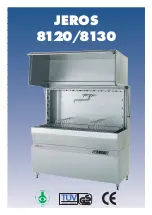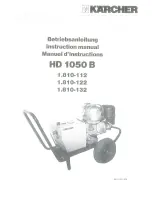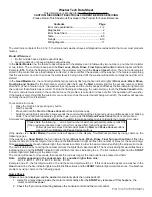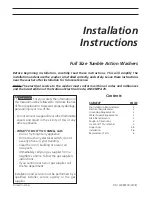
rinsing should also progress from the bottom
upwards. On particularly tough stains it may be
necessary to use a brush in combination with
detergents and high pressure rinsing.
Operation
The following cleaning procedure will help you
organize your cleaning task and ensure that
you achieve the most beneficial results in the
shortest amount of time. Remember to use the
spraying/ cleaning techniques previously listed.
1. Surface preparation
It is important to prepare the surface that is to
be cleaned. This is done by clearing the area of
furniture and making sure that all windows and
doors are closed tight. In addition, you should
make sure that all plants and trees adjacent
to the cleaning area are protected by a drop
cloth. This will ensure that your plants won’t be
sprayed by the detergents.
2. Initial High Pressure Rinse
The next step is to spray the cleaning surface
with water to clear off any dirt or grime that may
have collected on the surface. This will allow
your detergent to attack the deep down dirt that
has worked its way into the cleaning surface.
Before triggering the gun, adjust the nozzle to a
wide fan pattern and slowly adjust to the desired
spray pattern. This will help you avoid applying
too much concentrated spray to the surface
which could cause damage.
TIPS FOR EXTENDING THE LIFE OF YOUR
PRESSURE WASHER
1. Never operate the unit without water.
2. This pressure washer is not designed to pump
hot water. Never connect it to the hot water
supply – this will significantly reduce the life of
the pump.
WARNING
3. Only use detergents specifically designed for
pressure washer. Other types of detergent may
cause internal damage to the unit, as might
chemicals such as bleach, washing-up liquid,
etc.
4. Never operate the unit for more than one (1)
minute without spraying water. Otherwise, the
resulting heat buildup will damage the pump.
5. Winter Storage:
For storage during the winter months we
recommend the use of a solution of 50/50 mix
of antifreeze and water. This will keep the pump
from freezing and getting damaged and will
protect the internal components.
Method: You will need a length of garden hose
and a funnel. Attach the garden hose to the
inlet and pour the antifreeze into the unit via the
funnel.
Switch the unit on for a few seconds to allow the
solution to flow through the system. Disconnect
your pressure washer from the mains power,
then pack away in your storage area.
WARNING:
Before reusing completely flush the
unit out with plain water. Anti-freeze can damage
paintwork so you must ensure there is no anti-
freeze left in the system before using it again.
-8-
All manuals and user guides at all-guides.com






























